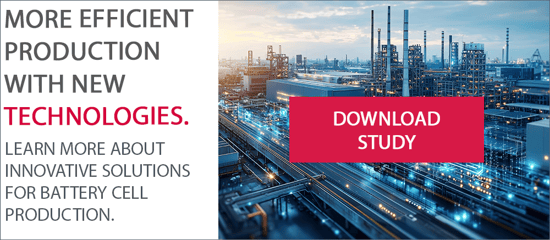How can European manufacturers keep pace with Asia in battery cell production? A recent study by EDAG provides answers. It analyzes 35 innovative technologies for the production of lithium-ion pouch cells and compares their impact on production processes, space requirements, and costs. A must-read for anyone planning, expanding, or rethinking battery cell production.
Read on – or download the complete study directly: Download
Europe under pressure
The global battery market is growing rapidly, driven by e-mobility. But while Asian manufacturers dominate around 92% of global cell production, Europe's share remains low. The EU wants to reduce this dependence by building up its own production capacities. The road ahead is challenging: complex technologies, high rejection rates, lack of scalability, and geopolitical uncertainties are slowing down many projects.
Comparison of innovative technologies
The study "Battery Cell Manufacturing: Implementation and Comparison of Innovative Technologies" by EDAG analyzes how innovative technologies increase the efficiency and cost-effectiveness of battery cell manufacturing. The focus is on 35 technologies along the process steps of electrode production and cell assembly. These technologies were systematically evaluated, interactions identified, and three layout concepts developed as examples to show how production space, investment costs (CAPEX), and operating costs (OPEX) can be reduced.
Interactions: Technologies in context
The chemistry and format of a battery cell have a decisive influence on the design of production processes and the technologies used. Changes in cell chemistry often require adjustments along the entire production chain. The chosen cell format, in turn, determines the type of cell assembly. In addition, innovative technologies in battery technology can exhibit complex interactions. These interactions harbor risks, but also opportunities—provided they are identified at an early stage.
"Innovation does not lie in individual technologies, but in how the product is evaluated and integrated into process chains. This is exactly where our analyses come in."
Dr. Ing. Anselm Lorenzoni, expert in battery cell production and smart factory planning, EDAG.
Technology comparison: 35 innovative technologies, three layouts
The study is divided into two main parts:
1. Technology analysis
35 technologies were examined. The following list shows a selection of the technologies:
Electrode manufacturing:
- Mixing: Twin screw extruder, Inline-disperser
- Coating: Screen printing process, Drycoating
- Drying: diode laser drying, light-initiated thermal emission
- Calendering: rotating roller pairs with inspection
- Slitting: Laser slitting
- Vacuum drying: Roll-to-roll post dryer
Cell assembly:
- Separate: Laser cutting
- Winding & stacking: Lamination process
- Contacting: laser welding
- Housing: Laser welding
Note: The complete list of technologies examined, including evaluations, can be found in the study.
2. Concept layouts and evaluationBased on these analyses, three sample concept layouts for battery cell production were developed and compared with the state of the art (SoA).
- Layout 1 shows improved quality with minimal space savings.
- Layout 2 impresses with improved quality, high production speed, and a reduction in total floor space of over 10,000 square meters.
- Layout 3 impresses with maximum production speed and a reduced footprint of more than 8,000 square meters.
All three concept layouts enable cost savings in the millions.
Virtual battery cell production: minimizing risks, maximizing potential
Virtual battery cell production is a key tool for technological and economic evaluation. It enables complete production scenarios to be mapped realistically and interactively long before real production lines are set up. Real data is linked to simulation-based models of innovative technologies in order to analyze interactions between individual process steps, resource utilization, and effects in a targeted manner. The underlying data is organized in a structured manner via a dedicated domain, which optimizes comparability and scalability.
"Based on virtual battery cell production, we simulate complete production lines and make the effects of innovative technologies immediately visible – technologies can be compared directly."
Philipp Hummel, Senior Manufacturing Engineer, Smart Factory Planning, EDAG
Using virtual reality applications, planners and stakeholders can enter virtual production areas, select technologies, and compare key figures such as CAPEX, OPEX, space requirements, and scalability ( ). This creates an intuitive environment that not only impresses from a technical standpoint but also improves collaboration between departments.
Virtual battery cell production enables valid, data-based decision-making in early planning phases. It accelerates the evaluation of technological options in terms of efficiency and sustainability, reduces integration risks, and identifies cost-cutting potential at an early stage.
Recommendations for cell manufacturers, machine builders, and technology providers:
- Evaluate interactions early on: Consider technologies in context, not in isolation
- Use virtual tools: Simulation and digital twins with the integration of machine learning and AI applications
- Consider standardization: High TRL values ensure planning reliability
Conclusion: From idea to scalable production – with virtual battery cell manufacturing
The analysis of 35 innovative manufacturing technologies and their evaluation within three concept layouts shows that efficiency gains, space savings, and cost reductions can be achieved if interactions are identified and systematically taken into account.
The layout concepts presented are more than theoretical scenarios – they demonstrate in concrete terms what is already possible today with virtual battery cell production. By linking real process data with digital models at an early stage, a valid basis for decision-making is created that reduces technological uncertainties and accelerates the implementation of industrial battery cell production.
Virtual battery cell manufacturing is therefore not just a tool, but a strategic enabler for establishing competitive, flexible, and sustainable battery cell production in Europe.
Thanks to our partners
The study "Battery Cell Production: Implementation and Comparison of Innovative Technologies" was only possible thanks to the dedicated cooperation of numerous partners. EDAG would like to thank all participating cell manufacturers, machine builders, research institutions, and technology providers who contributed significantly to the success of this analysis with their expertise, data, and openness.
Take action now: cooperation instead of going it alone
The establishment of efficient battery cell production in Europe can only succeed through close cooperation. EDAG invites manufacturers, technology providers, and research institutions to join forces in further developing the database of innovative manufacturing technologies and sharing new findings. If you have any further questions, please feel free to contact our expert Philipp Hummel, Senior Manufacturing Engineer, Planning Smart Factory. Or download the study here, find out more, and play an active role in shaping battery cell production in Europe.
Published on: 13.08.2025
Last updated on: 02.10.2025






